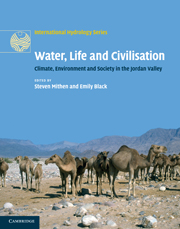Book contents
- Frontmatter
- Contents
- List of figures
- List of tables
- List of contributors
- Acknowledgements
- 1 Introduction: an interdisciplinary approach to Water, Life and Civilisation
- Part I Past, present and future climate
- Part II The palaeoenvironmental record
- Part III Hydrological studies of the Jordan Valley
- Part IV Human settlement, climate change, hydrology and water management
- Part V Palaeoeconomies and developing archaeological methodologies
- Part VI Society, economy and water today
- 24 Current water demands and future strategies under changing climatic conditions
- 25 Water reuse for irrigated agriculture in Jordan: soil sustainability, perceptions and management
- 26 Social equity issues and water supply under conditions of ‘water stress’: a study of low- and high-income households in Greater Amman, Jordan
- 27 The role of water and land management policies in contemporary socio-economic development in Wadi Faynan
- 28 Political discourses and public narratives on water supply issues in Amman, Jordan
- Part VII Conclusions
- Index
- Plate section
- References
25 - Water reuse for irrigated agriculture in Jordan: soil sustainability, perceptions and management
from Part VI - Society, economy and water today
Published online by Cambridge University Press: 26 April 2011
- Frontmatter
- Contents
- List of figures
- List of tables
- List of contributors
- Acknowledgements
- 1 Introduction: an interdisciplinary approach to Water, Life and Civilisation
- Part I Past, present and future climate
- Part II The palaeoenvironmental record
- Part III Hydrological studies of the Jordan Valley
- Part IV Human settlement, climate change, hydrology and water management
- Part V Palaeoeconomies and developing archaeological methodologies
- Part VI Society, economy and water today
- 24 Current water demands and future strategies under changing climatic conditions
- 25 Water reuse for irrigated agriculture in Jordan: soil sustainability, perceptions and management
- 26 Social equity issues and water supply under conditions of ‘water stress’: a study of low- and high-income households in Greater Amman, Jordan
- 27 The role of water and land management policies in contemporary socio-economic development in Wadi Faynan
- 28 Political discourses and public narratives on water supply issues in Amman, Jordan
- Part VII Conclusions
- Index
- Plate section
- References
Summary
ABSTRACT
Treated domestic wastewater offers a valuable contribution to Jordan's water balance. Water reuse is particularly well-suited to irrigated agriculture, for which water is in constant demand. The Jordanian reclaimed water generally has a high concentration of both plant-beneficial ions (nutrients) and potentially plant-toxic ions. Suitable soil management strategies such as periodic leaching and nutrient management are therefore required to maintain productivity. In this research the effect of water reuse on soil sustainability has been investigated by means of soil analysis combined with interviews with farmers and organisations working with reclaimed water. The soil analysis results suggest that irrigation does lead to the accumulation of plant-toxic solutes, but soil analysis from farms which have been irrigated with reclaimed water for several decades reveals that solute accumulations have been avoided through water management strategies on the farm. Interviews with farmers have shown that on-farm water management is influenced by a range of factors, which include the decisions taken by organisations with regards to water allocation and management. Interviews with organisations have shown that the priorities of decision-makers are often different from those of farmers and that they have a limited awareness of the challenges faced by farmers. Maintaining soil sustainability is imperative and can be achievable through water management both on and off the farm.
- Type
- Chapter
- Information
- Water, Life and CivilisationClimate, Environment and Society in the Jordan Valley, pp. 415 - 428Publisher: Cambridge University PressPrint publication year: 2011
References
- 3
- Cited by



